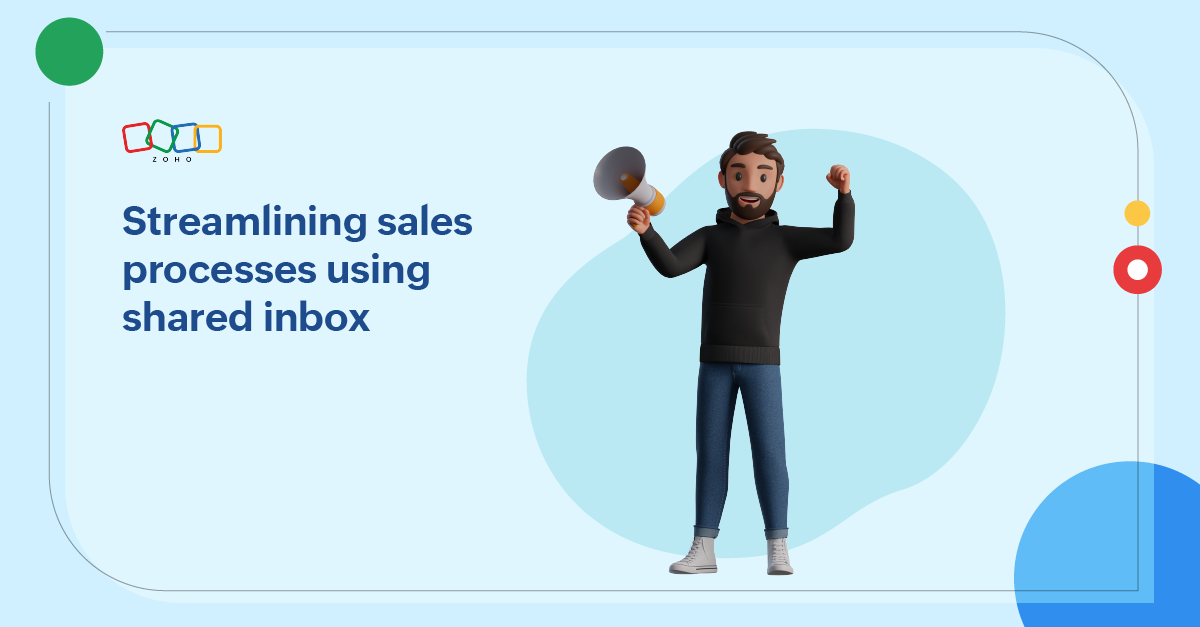- HOME
- Thought leadership
- The shift towards collaborative sales: Streamlining processes using shared inbox
The shift towards collaborative sales: Streamlining processes using shared inbox
- Published : April 7, 2023
- Last Updated : November 2, 2023
- 579 Views
- 8 Min Read
The lone wolf vs. the pack leader
Traditionally, sales have been carried out by independent "lone wolves" solely focused on achieving their targets. However, over the years, this approach has shifted towards teamwork and collaboration in the sales process. In today's business environment, the sales and marketing teams are jointly responsible for driving profits. Marketing generates leads through campaigns, which are then nurtured before passing them to the sales team. The sales team then works on converting the qualified leads. Therefore, sales success is dependent on effective communication and cooperation between the sales and marketing teams, emphasizing the need for teamwork and collaboration in the modern sales process.
In order to manage this process efficiently, many organizations use a customer relationship management (CRM) system that both teams have access to.
Inside CRM
Marketing teams segment and label the leads they generate before they upload them into CRM. They also access the marketing qualified leads (MQLs) to run campaigns and sometimes use the entire database to send special mailers, such as newsletters.
The lead list is accessed by sales teams based on the segments that are relevant to them. For example, a salesperson who focuses on small and medium-sized businesses (SMBs) and startups can get leads labeled as SMBs and startups, whereas a salesperson who focuses on large clients can access leads labeled as enterprise.
Geographic segmentation is another method of grouping leads; for example, an account manager assigned to the APAC area would only have access to leads from that region. Before uploading leads, each firm defines and segments them based on its sales procedures.
Collaborations in the sales cycle
The sales team greatly benefits from working together with a number of teams through out the sales cycle, such as:
Technical consultants. Sales teams must constantly seek out technical knowledge about the capabilities and functionality of the products or services. They also need to discuss the concerns and inquiries of their customers in order to advance the sales cycle. They need the technical experts to provide prospects with a thorough demonstration of the products or services. When the sales team can respond confidently to any technical queries from prospects as a result of this teamwork, the prospects' faith in the product or service is increased.
Marketing/content team. Collaboration between the sales and marketing teams enables the sales team to seek specific sales materials and content, such as battle cards, competitor comparisons, and price calculators from the marketing team. They also seek the marketing department’s help to develop special deals or discounts for potential customers. They may make sure that the offer fits the prospect's needs, interests, and pain areas by collaborating in real-time.
Product management. Sales teams collaborate with product management teams to get detailed information on product features and functionalities, as well as the product roadmap. This collaboration allows sales teams to provide accurate information to prospects—including details about feature releases—showcase product differentiators, and position the product effectively in the market.
Other teams. Sales teams also need to collaborate with a number of other teams, including legal, support, compliance, security and privacy, and more when filling out complicated RFP forms from prospects during their vendor evaluation. Continuous teamwork is required to gather data, shorten the RFP process, improve accuracy, and increase the chances of closing the deal.
Challenges faced by sales teams
According to a 2023 LinkedIn poll, 40% of respondents reported longer sales cycles, 26% reported fewer inbound leads, and 18% reported fewer sales conversations. Only 16% of respondents reported thriving.
Various external and internal factors, such as market conditions, competition, technology, or changes in customer behavior, can be attributed to these statistics.
Ineffective sales processes and organizational silos are significant factors that contribute to longer sales cycles and reduced sales conversations. The sales teams must collaborate with various departments throughout the sales cycle. However, these departments have their priorities and work independently, which creates challenges in working together.
Furthermore, the use of email and team chat to collaborate with these teams can also create a lot of noise, making it challenging to find relevant information. For instance, including multiple teams in a single email thread can lead to confusion and delays as it becomes difficult to track who is responsible for which tasks. Similarly, creating dedicated channels on a team chat can lead to an overwhelming number of notifications, causing distractions and hampering productivity.
Sales teams must find more efficient and effective ways to collaborate with other teams in the organization without compromising their productivity. This may involve streamlining people, processes, and tool stacks and breaking the silos to improve collaboration.
Streamlining the sales process through a shared inbox
A shared inbox is a group email management tool with a variety of applications, such as team collaboration, customer service, internal support, and defining operational processes across departments. Multiple users may access, read, manage, and send emails thanks to the tool's single collaboration space.
Setting up a shared inbox for a sales team can help streamline communication and ensure that everyone is on the same page.
Setting up a shared inbox
By setting up a shared inbox with clear organization and access for relevant team members, a sales team can improve collaboration and ensure that all customer inquiries are handled efficiently.
The first step is to create a unified inbox for the team around group emails such as sales@company.com. Once the inbox is set up, the sales reps can be onboarded and given access to the shared inbox. It's important to add other relevant team members to the group, such as technical consultants, support team, marketing leads, and project managers who may need to be involved in sales conversations. To further organize the inbox, subgroups can be created based on region or product, such as apac-sales@company.com or UK-sales@company.com.
Setting up processes and predefined email templates
To streamline sales processes and increase efficiency, it’s important to identify steps that can be automated within a shared inbox. One way to do this is by setting up automated emails for inquiries from lead generation forms and sign-ups for free trials.
Defining stages of onboarding and creating a DIY checklist and knowledge base for each stage can also help make the process more efficient.
Templates: Pre-determined email templates for cold emails, incoming inquiries, and various stages of onboarding can be created with necessary attachments to further simplify the sales process.
Assigning sales reps, delegating emails, and prioritizing leads
Assign: The admin or the sales lead can assign sales representatives based on the type of account or geography to make sure that the most appropriate person is handling each account. For instance, a sales rep who has experience with a specific type of account, such as health care or finance, could be assigned to handle those accounts.
Prioritize: Once the sales reps receive the emails, they can use colored tags to sort them and add context to each email. This helps them to quickly identify the stage of the sales cycle that each lead is in, assign tags as leads move through different stages of the sales cycle, and even add notes to each email to keep track of important details. This allows them to have a better understanding of the needs and interests of each lead.
The shared inbox tool provides the option to use tags to modify the lead score assigned to individual conversation threads.
The shared inbox tool allows sales teams to manage communication with potential customers and assign a lead score to each conversation thread based on the prospect's interest and potential. Adding a specific tag, such as "High Interest," to a conversation thread can automatically adjust the lead score to reflect the increased likelihood of a successful sale. Similarly, a tag like "Low Priority" can be used to adjust the lead score for conversation threads that indicate decreased interest. With this feature, lead management and prioritization can be efficiently handled within the shared inbox tool.
Delegate: Additionally, the assigned sales reps can delegate their emails to other team members in case of holiday or sick leave or some other urgency. This ensures that someone is always available to respond to important emails and that no leads or opportunities are missed.
Enhancing sales team collaboration
Unified inbox: By adding relevant teams, such as marketing, technical consultants, support, and product management to group inboxes, sales teams can streamline communication and ensure that everyone is on the same page at every stage of the sales lifecycle.
@mention: Using features like @mention, sales team members can loop in the relevant personnel by mentioning them directly in the email thread. This eliminates the need for cumbersome and time-consuming back-and-forth email forwards, and the need to switch to a different chat box for discussions. For instance, a sales rep could @mention a technical consultant to provide insights on a specific technical aspect of a product being offered.
Co-author: Teams can collaboratively compose and edit emails that are being sent to customers. This is particularly helpful in scenarios where multiple stakeholders or team members are required to respond to customers' questions. For instance, a sales rep could draft an email, and other team members could edit it to provide a comprehensive and personalized response to the customer, which can help build trust and increase the chances of closing the deal.
Use case: When prospects reach out to a company's official social media handles for product inquiries and other details, the company can receive notifications of the messages and comments if they have configured a group email with the social media handle. Using a shared inbox tool, the company can seamlessly triage these messages and comments amongst relevant teams, such as sales, support, product management, or legal/compliance, without sharing social media credentials or access. When the relevant teams are a part of the unified inbox, they’ll have visibility into the social handles, or use @mention to initiate a conversation with relevant personnel on specific threads. The relevant personnel can then discuss in the comments or even collaborate on the response to be sent to the prospect. This approach enables efficient management of social media inquiries and enhances customer engagement.
Optimizing sales processes with analytics
Shared inboxes give sales teams an opportunity to use analytics features to gain insights into their business development processes. By tracking metrics such as response times, email volume, and customer engagement, sales teams can track team and individual performance, benchmark and compare internally and by month, and gain insights into team and individual growth. This identifies areas for improvement and provides targeted training to team members.
Contextual integrations
CRM: A shared inbox integration with a CRM system can provide sales teams with a centralized platform to manage customer interactions, allowing them to track the customer's journey through the sales pipeline and personalize their outreach accordingly. The integration can help sales teams automate repetitive tasks, freeing up more time for reps to focus on high-value activities, such as closing deals.
Zapier: Zapier integration with a shared inbox can provide sales teams with a powerful platform to automate tasks and streamline their workflows, making it the command center for your daily operations across teams. Learn everything you can do with the shared inbox and Zapier integration.
Conclusion
Sales success in today's business landscape depends not only on individual performance, but on effective communication, collaboration, and teamwork across multiple departments. Sales teams must collaborate closely with other teams such as marketing, product management, and technical consultants to streamline the sales process and efficiently close deals.
However, issues such as extended sales cycles and organizational silos can impede collaboration. A shared inbox is a unique system of engagement built on top of traditional email that can help overcome these challenges. By providing a centralized communication platform for all teams involved in the sales process, a shared inbox allows for real-time collaboration, reduces response times, and improves overall communication within the organization. As a result, shared inboxes can help break down organizational silos, enhance the collective expertise of teams, and ultimately drive profits more effectively.
- Sandeep Kotla
Sandeep is an inbound marketer with Zoho Corporation. Previously, he handled analyst relations and corporate marketing for ManageEngine (a division of Zoho Corp) and its suite of IT management products. He currently spends most of his time re-imagining and writing about how work gets done in large organizations, reading numerous newsletters, and Marie Kondo-ing his inbox.



